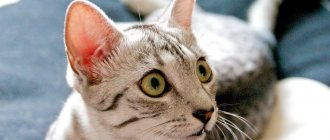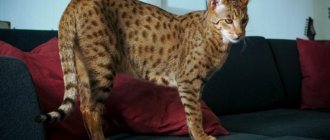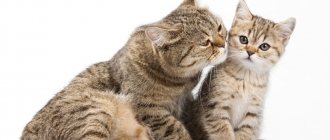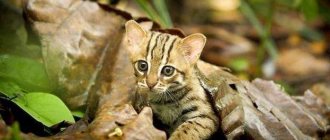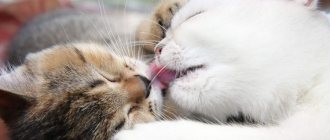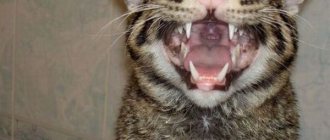The Burmese cat is one of the most beautiful pets. Burmese cats are very colorful due to their amazing color and soft length of fur. Calm, obedient, sociable and inquisitive, Burmese cats have coexisted peacefully next to humans for centuries, showing their emotional affection.
Brief history of the breed
The homeland of these cats is considered to be the peninsular state of Myanmar - as mysterious as the Bermuda Triangle, and until 1989 called Burma. Their history began in ancient times, and today it is almost impossible to say exactly where they came from.
It is known for certain that in ancient times similar cats lived at Buddhist temples. These animals supposedly protected them from robbers and dark forces.
There are many beautiful legends associated with the origin of Burma. It is possible that several breeds took part in its formation. Experts suggest that among her relatives are a short-haired Siamese and a fluffy Angora or Persian. For a long time, the Burmese cat was distributed only in Indochina.
In Europe they learned about it only in 1919, when the millionaire Vanderbilt brought it to France. For a lot of money, he bought two kittens, one of which died before reaching its destination. And the surviving female subsequently gave birth to babies, from which European breeding of the Burma began.
In 1925, the breed was officially registered in France. Today, the Burmese cat is recognized by all felinological associations in the world.
Recommendations for breeding the breed
It is very difficult to obtain a purebred Burmese cat that maintains all the species’ qualities and meets the standard requirements. Therefore, the price for such a kitten is very high, and it can only be purchased in professional nurseries that are seriously involved in breeding work.
You can breed the breed at home, but the likelihood of breeding kittens with minor defects in color is much higher. Otherwise, the pets are fully consistent with their gene pool.
Criteria for choosing a partner
Selecting a suitable partner for mating is a long and difficult process for a beginner.
Main criteria to pay attention to:
- genetic health;
- breed matching;
- combination of color lines;
- presence of purebred ancestors.
For a young cat, it is best to choose an experienced partner, since two beginners may not be able to cope with this process the first time.
The parent pair should be prepared for mating at least a month in advance. Both pets must be healthy and vaccinated against parasites, both internal and external. It would be a good idea to check with your partner’s owner about his state of health and find out about the presence of chronic diseases.
At what age should you give your pet for the first mating?
The first mating should be carried out no earlier than the pet reaches one and a half years old. But before this, the cat must go through 2 heats, and on the third one you can mate. Mating is carried out on the third day of estrus. You should first trim the claws on the front paws of both the cat and the male cat.
Earlier mating negatively affects the health of parents and future offspring.
How often can a cat give birth?
Mating of a cat should be carried out no earlier than 8 months after the previous birth. The most favorable possibility is to mate once every 10-12 months.
Ignoring these deadlines has a negative impact on the well-being of the Burmese cat.
Interesting Facts
During the existence of the Burmese cat breed, a lot of interesting things happened to it:
- There is a beautiful legend associated with these animals. It is believed that Burma owes its unusual appearance and blue eyes to the goddess Tsun Huanze. During a battle with robbers who attacked the temple, a monk died. At that moment, his cat's yellow eyes turned sapphire, and his paws, immersed in the priest's gray hair, turned white. The frightened robbers, unable to resist the gaze of blue eyes, left the temple. After this incident, the breed received the name “sacred Burma”.
- These cats are real record holders. The female named Antigion became the most fertile - she gave birth to 19 kittens at once.
- Another sacred Burmese cat named Catalina was included in the pages of the Guinness Book of Records as the oldest - she lived for 35 years.
How to cope with loneliness
The Sacred Burma is a very social animal and does not tolerate loneliness well. Past life experience is of great importance to her. A kitten raised in a large family will constantly need affection and extra attention.
It is very good if one of the household members is always at home. In this case, the pet will not be deprived of attention. If adults and children go about their business every morning, leaving the Burmese alone to while away the time in the apartment, he may feel lonely. In the evening, you need to reward the sufferer by giving him maximum attention and participation.
It is highly not recommended to leave Sacred Burma alone for a long time. Being isolated and separated from its beloved owner, the pet will experience severe psychological discomfort, which can develop into depression.
Breed description, standards, appearance
The Birman is a harmoniously built, stocky cat with well-developed muscles and a slightly elongated body. Her body is covered with silky semi-long hair of beautiful colors, in harmony with her sky-blue eyes. The exterior of the Burmese cat is described in more detail in the official standard.
Dimensions and weight
Burmese cats are a medium-sized breed, although their thick coat makes them look larger. An adult male weighs about 5-6 kg. The average weight of a female is 3-4 kg.
Anatomical characteristics
A typical Sacred Burmese breed should meet the following description:
- The head is proportional, almost round, with a wide muzzle, moderately long nose, strong chin, prominent cheeks and prominent cheekbones.
- The eyes are large and widely set. The color of the iris varies from light to dark blue.
- The ears are located on the sides of the head, slightly tilted forward. Hair grows profusely on the inside of the shell.
- The body is squat, elongated, with developed muscles, powerful bones and a muscular neck.
- The limbs are of medium length, thick with large round paws and strong claws. The interdigital space is overgrown with tufts of hair.
- The tail is of medium length, with rich feathering.
Color and coat type
The entire body of the sacred Burmese is covered with thick, luxurious semi-long hair, which forms fluffy “pants” on the hind legs and a chic “collar” on the neck.
The color of the representatives of the breed is similar to the color of the Siamese. There are clearly defined markings against a basic light background. The classic Burmese cat pattern is a chocolate brown pattern on a light beige coat.
The following colors are also acceptable in the breed:
- seal point;
- blue point;
- cream;
- lilac;
- red;
- cake;
- tabby
Important! The main characteristic that allows you to distinguish the sacred Burmese from cats of other breeds is the presence of pairs of symmetrical white “gloves”. On the front legs they do not rise above the pastern. On the hind legs they end in a sharp “spur” reaching to the middle of the lower leg.
Possible breed defects
Disadvantages in the presence of which the Burmese cat will not receive a high expert assessment:
- colored spots on the stomach and back;
- lack of “gloves”;
- eye color other than blue;
- knobby or curved tail;
- strabismus.
Health
The Burmese cat rarely gets sick - its immunity is developed and strong. Its lifespan ranges from 10 to 15 years, but with proper care, the pet often lives up to 20 years. Genetic and hereditary defects:
- cardiomyopathy;
- corneal dermoids;
- problems with the vestibular apparatus.
Cardiomyopathy
Burms are susceptible to all types of cardiomyopathy. There are four in total:
- Hypertrophic. It occurs most often and manifests itself in thickening of the heart walls of the left ventricle. Because of this, the rhythm of contractions and the supply of oxygen to the body is disrupted.
In hypertrophic cardiomyopathy, the walls of the ventricles thicken and the heart is unable to pump blood. - Dilatational. In this case, the heart itself will increase, and not the walls (which, accordingly, will become thinner). The organ in this state looks like a barely formed mass. Oxygen starvation of the whole body is one of the obvious symptoms.
With dilated cardiomyopathy, the muscular walls of the heart are stretched and cannot contract at the desired rhythm. - Restrictive. The elasticity of the heart is lost. The body lacks oxygen. The “fastest” of cardiomyopathies kills the animal in a year, maximum two.
- Intermediate. There is no exact definition of the disease, since the intermediate type combines the symptoms of several other cardiomyopathies. Because of this, it is considered the most dangerous and difficult.
Symptoms can be detected in the early stages by a veterinarian:
- galloping heart rhythm;
- arrhythmia;
- pulse pathology;
- heart murmurs;
- oxygen starvation (manifested in pallor of the mucous membranes, sudden changes in mood, gradually increasing depression);
- hypertension.
Cardiomyopathy rarely “comes” alone - it can develop against the background of “bull’s heart”, acromegaly, lymphoma. In such cases, with timely detection of the disease, it is possible not only to alleviate, but also to eliminate the pathology (although the heart will be damaged and the animal’s life expectancy will be significantly reduced). Heredity may also be a cause.
Corneal dermoids
This disease is characterized by the appearance of a dermoid tumor on the cornea of the eye. The affected area looks like skin covered with hair (in general, the structure of a dermoid resembles skin: it has glands and skin layers like the dermis and epidermis), the tumor cavity is filled with fat. Treatment is surgical removal of the dermoid. The disease does not cause relapses.
Corneal dermoid is a growth on the cornea covered with hair.
Problems with the vestibular system
Clinical signs of this disease appear at 3–12 weeks of development, but then may go away on their own. Early symptoms include difficulty getting up on all four legs. It seems that the cat is about to fall in the first seconds. At the same time, the animal’s head tilts to the side, and nystagmus (involuntary oscillatory movements of the eyes) can often be seen. The sick cat takes a few normal steps, after which it freezes for a while, swaying, as if “gathering its thoughts.”
All this is due to disruption of the vestibular apparatus, that is, a complex organ-nervous complex that ensures the preservation of balance and orientation in space. In mild cases, violations, although they look very alarming, are in fact almost harmless. Unfortunately, everything does not always end well.
Character and temperament
The Sacred Birman is a calm, balanced and moderately active cat. She is very friendly, affectionate and playful. At the same time, she knows how to control herself and shows nobility in any situation.
The Burmese cat, whose character combines the desire for independence and dislike of loneliness, will not tolerate an indifferent attitude. She gets along with children without any problems and even in the midst of play will not scratch a child.
The Sacred Birman is able to coexist peacefully with non-aggressive dogs and cats of other breeds. But it is better to keep ornamental birds, rodents and aquarium fish away, since the hunting instinct in a cat can awaken at any moment.
Burma and children
Burmese kittens get along well with children, especially if the babies are raised together from diapers. You can leave your pet with your child without fear, knowing that it will not bite or release its claws.
Usually Burmese people patiently endure the not very skillful caresses of babies. First, you should still talk to the child, explaining that the cat is a living creature and you need to be careful with it.
Older children who love and know how to handle animals tend to find contact with Sacred Burma. Children and animals often become best friends and enjoy playing together.
How to choose the right kitten
To be sure of the purebred and health of your future pet, it is advisable to buy it from a trusted breeder or a certified nursery. At the time of sale, Burmese kittens must have documents confirming their origin and a passport with vaccination marks.
Kids should be well-groomed, active and moderately curious. The health of Burmese kittens can be judged by their soft bellies, clear eyes, fresh breath, and the absence of dirt under the tail and scratches on the skin.
On a note. Kittens of this breed are born completely white. Sacred Burmas acquire their final color by the age of one and a half years.
Kitten care
Burmese kittens from good nurseries go to new homes fully vaccinated and quite independent. They already eat many foods, go to the litter tray and know how to use a scratching post. New owners can only give the pet time to adapt and show where the bowls and cat litter are located.
Since small Burms are very curious and playful, wires, indoor plants, household chemicals, fragile and small things are hidden from them in advance. And so that the kittens do not suffer as a result of the owner’s carelessness, the doors of washing machines and ovens are closed from them.
To avoid digestive problems due to a sudden change in diet, at first the small Burmese is fed what the breeder advised. New foods are introduced into the kitten’s diet in stages to observe its body’s reaction.
The feeding regimen is set taking into account the age of the sacred Burma:
- up to 3 months – 5-6 times a day;
- 3-6 months – 4 times a day;
- 6-12 months – 3 times a day.
From the age of one year, the Burmese cat is switched to twice feeding.
How much does it cost and where to buy
In order for a female to have purebred Burmese kittens, mating must be done at the age of one and a half years.
In one litter, from 3 to 7 kittens are born, in a rare case - 10 cubs. Purebred Burmese kittens can be purchased in Moscow nurseries or from reputable breeders.
Choosing a kitten
When choosing a Birman kitten, you need to carefully prepare. The price for Burmese kittens starts from 20 thousand rubles. The cost of a Burmese baby depends on the age of the kitten and the purity of the breed. The cub can be given away at the age of one month, when it begins to eat on its own. To achieve good immunity, Burmese kittens are given the necessary vaccinations.
Care and maintenance
Despite the luxurious semi-long hair, Burmese cats come from a country with a warm climate. Therefore, they cannot tolerate precipitation and cold, which means they are not suitable for outdoor keeping. It is advisable to house representatives of the breed in warm rooms where the air temperature is maintained at 20-25 °C.
And in order for the sacred Burma to look neat, it is provided with complete care:
- The claws of a cat of this breed are shortened with a nail clipper as they grow. This should be done very carefully so as not to injure living tissues and cause pain to the pet.
- The animal's eyes and ears are regularly checked for any unusual discharge and wiped with a moistened cotton pad.
- The teeth of the sacred Burma are cleaned 2-3 times a month with a non-foaming paste, using a silicone brush or a special finger attachment.
- The coat of a cat of this breed does not require special care. In normal times, she is combed twice a week. During the molting period, the procedure is carried out more often to speed up the process. Bath your Burmese cat 3-4 times a year or as needed. To do this, use a special shampoo for fluffy breeds and warm water at a temperature of about 38 degrees.
On a note. Sacred Burma does not like water. To ensure that bathing procedures go quickly and calmly, cats are taught to bathe from an early age.
Health and diseases of the Burmese cat
Diseases of hereditary and genetic nature are rare in representatives of this breed, and all thanks to careful selection. In general, the health of Burmese cats is quite good. By making it a rule to regularly visit the veterinarian for preventive examinations and routine vaccinations, you thereby guarantee your pet an active life and longevity.
Cute Burmese kitten
The Burma's lifespan ranges from 12 to 14 years. There are happy exceptions to this rule - for example, the cat Lady Catalina. This representative of the Burmese breed from Melbourne, Australia was born on March 11, 1977 and lived for 35 years, getting into the Guinness Book of Records thanks to her longevity record. Burmese cats are also distinguished by their fertility; the number of kittens in one litter can reach 10. It is a documented fact that a cat gave birth to 19 babies at once, and this is also a record.
In some very rare cases, Burmese people suffer from a heart disease called hypertrophic cardiomyopathy. Its symptoms - shortness of breath and cough after active games, lethargy - usually begin to appear from an early age. Burmese cats also have pathologies of the vestibular apparatus and corneal dermoids. The latter can be successfully treated with a course of special antibiotics, but provided that the disease is not advanced. Regular deworming and age-appropriate vaccinations are provided as preventive measures.
In order for a cat to wear down its claws, it must be accustomed to a scratching post. Try to place the house or bed for your pet low, since climbing almost to the ceiling is not the style of the sacred Burma, she is a sedate animal. The bed should be made from natural materials; any “chemistry” can negatively affect the health of the Burmese.
Feeding the cat
Unlike representatives of many other breeds, the Burmese cat is not prone to gluttony and gaining excess weight. No matter how much food is in her bowl, she will not eat more than she needs.
Since for the sacred Burma it is not the volume, but the quality of food that is important, the cat’s diet should be as complete and balanced as possible. The easiest way is to feed your animal premium or super premium dry food.
It is important that it contains enough protein and does not contain questionable ingredients such as soy, dyes and preservatives. The following brands of food are eaten best by sacred Burmas:
- Pronature;
- Hills;
- Bosch;
- Grandorf.
With a natural type of food, the cat’s diet is designed so that the share of meat is at least 70-80%. Also given to the sacred Burma:
- boiled vegetables;
- eggs;
- offal;
- porridge with water;
- lean sea fish;
- dairy products.
Sacred Burma should not be given bones, sweets, baked goods, fatty meats, river fish, sausages and pickles. It is also forbidden to feed the cat mushrooms, smoked meats and any leftovers from the owner’s table.
Kitten selection criteria
When purchasing a Burmese kitten, you must choose a nursery that has the appropriate documents and certificates and has a good reputation, which has been confirmed over many years. This is due to the fact that the characteristic color of the animal begins to appear only from the age of three months. Therefore, when purchasing a pet at an earlier date, you should rely on the integrity of the manufacturer.
The cost of a purebred representative of the breed is $550-700. The price largely depends on the conformity of the species qualities of the breed, but if a pet is purchased purely for home keeping without the prospect of further breeding, then you can buy a kitten much cheaper.
It is necessary to choose a kitten from a common litter based on its behavior. The pet should be active, but not too aggressive, and not hide in a corner when trying to pick it up. It would be useful to look at the conditions in which the baby is kept and see his parents, which will confirm the purebred of the pet.
Otherwise, selection criteria should be based on general health:
- eyes, ears and mouth must be clean, without any discharge or unpleasant odor;
- there should be no bulges or seals on the spine and tail area;
- the kitten should walk smoothly, jump easily and move freely onto its hind legs if necessary;
- a swollen round belly does not indicate that the baby is eating properly, but that the pet is infected with worms;
- the skin on the paw pads should not peel off, and the claws should be free of defects;
- the wool should have a characteristic shine. Clumped fur in the anal area indicates digestive problems;
- The nasal sinuses should be free of crusts, and when sneezing, mucus should not fly out of them.
To make sure you make the right choice, you can try playing with your baby or offering him a treat. A healthy kitten will respond enthusiastically to any of these suggestions.
Education and physical activity
Burmese cats are endowed with high intelligence and excellent memory. They easily get used to the rules established in the owner's house and get accustomed to the tray and scratching post.
Burmese cats do not refuse to play and walk outside, but they can do without them. Unlike most other breeds, they do not land well. Therefore, sacred Burmese cats must be protected from jumping and accidental falls from heights.
Where to buy a kitten
Due to its high cost, the sacred beauty Burma is quite rare; kittens are bred in well-known nurseries. You need to buy a kitten there, because in the markets or from your hands you can get not a beautiful Burmese, but perhaps a cute, cuddly cat, but one that has absolutely nothing to do with the real Burmese miracle. A kitten purchased from a nursery will definitely give you positive emotions from interacting with this inquisitive, intelligent, very characterful baby. And don’t forget that kittens are as white as snow until they are six months old.
Vaccinations and antiparasitic treatment
To prevent viral and infectious diseases, the sacred Burmese cat is regularly vaccinated against rhinotracheitis, calcivirosis and panleukopenia. The first vaccination is given to the animal at the age of 7-8 weeks.
After 4 weeks, the Burmese kitten is re-vaccinated against the same diseases and against rabies. Subsequently, the cat is vaccinated once a year.
To protect the sacred Burma from diseases carried by parasites, it is periodically treated against fleas and worms. Anthelmintic drugs are given to the cat twice a year with mandatory repetition after 10-14 days.
To combat fleas, drops and shampoos are used. And if a Burmese cat goes outside even occasionally, it is additionally protected with an anti-parasitic collar.
Diseases
Burma's health is good: the immune system successfully resists most dangerous infections, therefore, if you follow the vaccination schedule, you will not encounter diseases such as panleukopenia, rabies, rhinotracheitis, calcivirosis and the like.
But genetic problems - alas! - happen often. This is due to the limited gene pool.
- Hypertrophy (hypertrophic cardiomyopathy) – the ventricle of the heart decreases, which leads to a decrease in the volume of blood pumped, the risk of heart failure and the formation of blood clots. Symptoms: decreased activity and body temperature, shortness of breath, asthma attacks, paralysis. Complex treatment is required, in some cases surgery.
- Corneal dermoid is a congenital benign formation in the eye area. Treatment is surgical.
- Body tremors - appears in kittens. The reasons can be different: relaxation during sleep, the kitten is cold, scared or very happy, in some cases it occurs after the animal has had a hearty lunch. But if the trembling does not go away, do not put off visiting the veterinarian! This may be a symptom of cystitis, rhinotracheitis or herpes virus infection.
- An increased concentration of creatinine in the blood indicates kidney problems.
Spongiform degeneration, a lesion of the nervous system, stands apart. The cat begins to worry, it salivates, there is loss of orientation, and muscle tremors. Infection occurs through food. Unfortunately, there are no means of prevention at the moment, with the exception of strict control over food and processing of meat products.
Expert opinion
Dusheba Vera Ivanovna
In 2010, she graduated from the Moscow State Academy of Veterinary Medicine named after K.I. Scriabin with honors, specializing in veterinary medicine. I regularly attend veterinary conferences, congresses, and webinars.
Veterinarians do not recommend spaying or neutering Burmese cats (unlike many others). Both the first and second operations are not simple, and they should be resorted to only in cases where the animals really suffer during periods of hormonal surges. For the Burmese, this time passes completely unnoticed and does not affect health or behavior, which means there is no need to resort to extreme measures.
Pros and cons of the breed
Reviews from owners of sacred Burmese cats are mainly about their external attractiveness and calm, non-conflict disposition. But among the owners of animals of this breed there are also those who are dissatisfied with the need to care for their pets’ thick, luxurious fur coat.
| pros | Minuses |
| Beautiful exterior | Unadapted to cold climates |
| Peaceful disposition | High cost of kittens |
| High intelligence |
The Sacred Birman is a cute shaggy cat with a good-natured and calm character. She will be an excellent companion for people who lead a measured lifestyle and are ready to give her warmth and care.
Are Burmese cats hypoallergenic or not? How often do they shed?
The Sacred Burma has a soft, silky coat without undercoat. If the cat is healthy and well-groomed, it will not shed much. Seasonal molting periods pass quietly. Care at this time consists of daily combing. This is quite enough to prevent the presence of a large amount of fallen hair on furniture and surfaces of the house.
The Burmese cat, to a lesser extent, but can still cause allergies in a sensitive person, because it is known that an allergic reaction does not develop to cat fur, but to a special protein contained in the secretion of the salivary glands, urine, sebum and other fractions that fall on the skin. surface of the coat. You can somewhat control the manifestations of allergies by frequently bathing your pet and observing personal hygiene rules.
It has been proven that in children, the body’s sensitivity to the Fel d1 protein develops less frequently if the child lives next to a furry pet from an early age. In this case, the immune system seems to adapt to constant contact with the allergen.
Owner reviews
- Marina : We have two cats with amazingly different characters, which manifest themselves in everything: Sonya is active and loves to walk. Hearing the command, he immediately runs to put on the harness. Harlequin defiantly lies down on the sofa, making it clear that at her advanced age, decent cats do not walk on a leash. During the trip, Sonya shows maximum activity and curiosity: she runs around the cabin and loves to look out the window. Harlequin sleeps in the carrier until the end of the trip.
- Tonya : The kitten quickly settled into our home and immediately found several secluded places where he could relax and play. Everyone immediately fell in love with him for his activity, love of the game and affectionate disposition. Never scratches small children and calmly endures all their squeezing. He mastered the litter tray and scratching post right away, and later learned to walk on a harness.
- Manyasha : Cats of the Sacred Burma breed are a little more than completely beautiful. They are simply amazing. Real kittens of this breed cost 600 euros. Yes, not a single breeder will give away a cat of this breed for free, because it is a real treasure. Burmas are difficult to breed. It is not surprising that professional breeders of this breed can be counted on one hand, and the requirements for the future owner are high.


